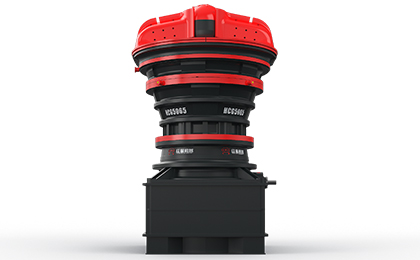Due to the demand for primary crushers with high capacity and large feed size, FTM Machinery has continuously improved and launched the HCG Series Gyratory Crushers.
What is a gyratory crusher?
A gyratory crusher is a type of large primary crushing equipment used in the mining, aggregates, and construction industries. Its processing capacity is as high as 14,082 t/h, and the feed particle size can reach 1,350 mm.
It handles medium to high hardness and aggressive materials. Therefore, it is ideal for dry to slightly wet materials, but not for sticky materials.
Compared with other types of stone crushers, gyratory crushers have a higher capital cost but are often preferred for their ability to handle high-capacity operations and abrasive materials.
Therefore, gyratory crushers are the first choice for medium and large factories.
How does a gyratory crusher work?
The rotary crusher operates by the rotary motion generated by the eccentric arrangement of the main shaft. The material is fed into the top of the crusher and is crushed between the crushing chamber and concave as it travels downward.
Then, the material is adjusted by the hydraulic cylinder to adjust the discharge granularity. Qualified material is discharged from the bottom opening.
If unbreakable materials such as iron pieces enter the crushing chamber, the hydraulic cylinder will lower the moving cone to release the iron pieces, and the crushing process will not stop.
The structure of the gyratory crusher
The gyratory crusher consists of a cone-shaped crushing head mounted on a vertical shaft. The vertical shaft hangs from the top of the crusher and is supported by a spider.
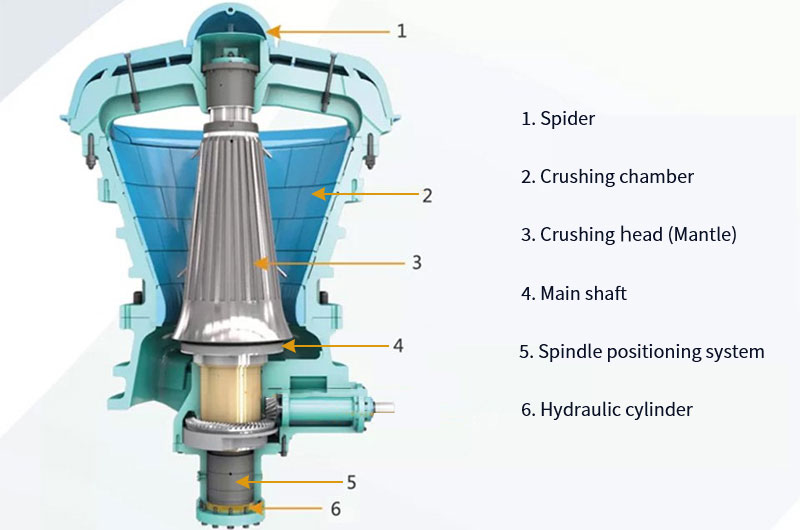
FTM Machinery has upgraded gyratory crusher spares many times and finally designed a large crushing chamber, high-strength main shaft, adjustable main shaft positioning system, hydraulic cylinder, and other parts.
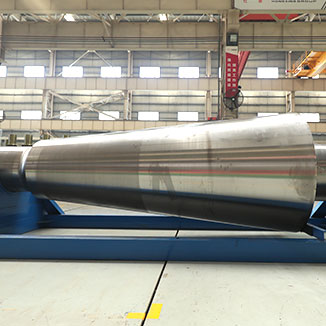
1. Main shaft
The main shaft is the vertical shaft that transmits the rotary motion from the motor to the crushing head. It is made of forged or alloy steel and is supported at the top by a star bearing assembly.
The one-piece forged spindle design makes it 70% stronger and avoids loosening of the mantle, reducing downtime.
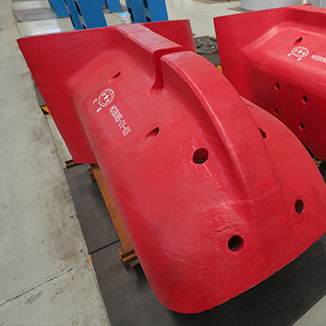
2. Spider
The star bearing assembly is a star bracket that holds the top of the spindle bearing. It consists of a spider hub (attached to the crushing mantle), spider arms, and bearings. It can reduce machine downtime and bridging.
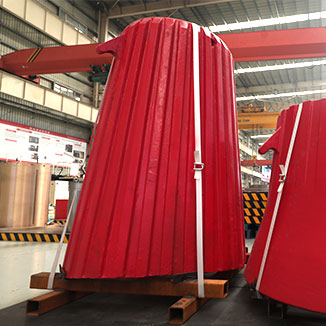
3. Crushing head (Mantle)
The crushing head, also known as the mantle, is a cone-shaped crushing surface fixed on the spider hub. It is typically made of manganese steel and is lined with concave liners on the inside.
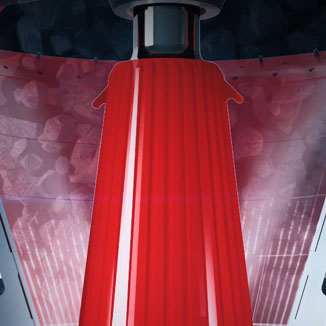
4. Crushing chamber
The crushing chamber is an inverted cone-shaped crushing space. Its feed port is 15% larger than that of similar crushers, and the feed size is as high as 1,350 mm.
The crushing cavity with a large inclination angle and long crushing surface design make the crusher have very high crushing efficiency. Liners are replaceable manganese wear plates for maximum life.

5. Spindle positioning system
The crusher is equipped with a standard displacement sensor. It enables operators to monitor and adjust the position of the main shaft, which can automatically compensate for liner wear.
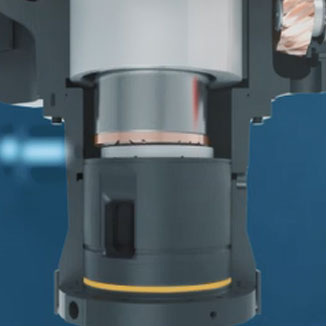
6. Hydraulic cylinder
The hydraulic cylinder automatically adds pressure to adjust the discharge port. This adjusts product particle size and compensates for liner wear.
It also provides an iron protection function. When the unbreakable object enters the crushing chamber, the hydraulic cylinder can automatically make the moving cone drop to release the object and protect the crushing chamber.
Why FTM Machinery gyratory crushers?
As a manufacturer of gyratory crushers for more than 40 years, we have these advantages:
- The large crushing chamber is easy to crush ores, which improves the crushing efficiency.
- Spindle design, hydraulic cylinders, and lubrication system can minimize downtime and maximize throughput.
- The crushing cavity wears evenly, which can reduce the number of liner replacements and decrease operating costs.
- Fully enclosed to prevent dust leakage.
- Visual operation for real-time observation of spindle position and machine operating conditions. This can enhance safety and maintenance.
Frequently asked questions about gyratory crushers
1. Gyratory Crusher Vs. Jaw Crusher
-
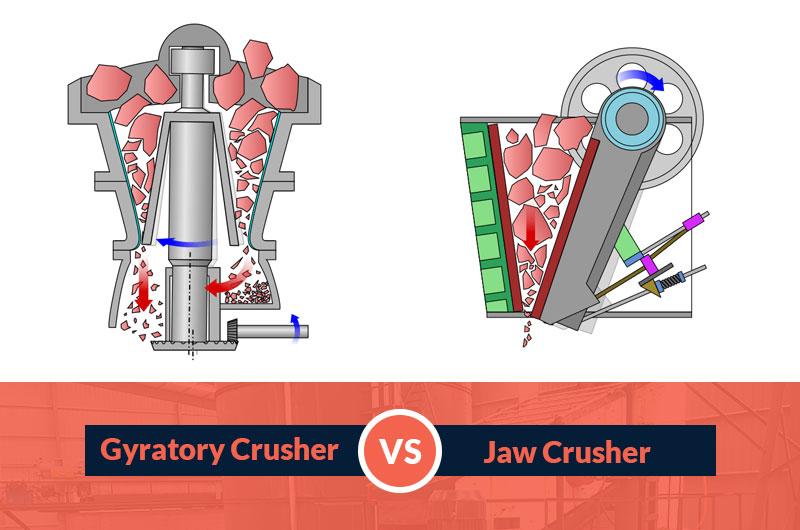
- a. Structure. The gyratory crusher has a complex structure, bulky body, and high investment. However, the jaw crusher has a simple structure, convenient maintenance, and low investment.
- b. Materials and scope. The gyratory crusher is particularly suitable for hard and abrasive materials. It is suitable for large mines, construction, and other industries. However, the jaw crusher performs better on high-moisture and high-viscosity ores, such as clay. It is suitable for small mineral processing plants and quarries.
- c. Feed size and output size. The gyratory crusher has an unlimited feed size and a small output size. It can produce small needle-shaped particles. However, the jaw crusher has a strictly controlled feed size and a feeder needs to be installed. Its discharged particles don’t have a good shape, which are mostly flat, sharp, or triangular needle-shaped.
- d. Maintenance. The gyratory crusher has longer service life and lower operating costs, but the worn parts are difficult to replace. Jaw crusher has easy maintenance of wearing parts.
- e. Environmental protection effect. The gyratory crusher has a fully-enclosed structure, with high sealing performance. However, the jaw crusher has a semi-closed structure. A large amount of dust is ejected during the crushing process, which may do harm to workers and the environment.
2. Gyratory Crusher Vs. Cone Crusher
- Gyratory crushers and cone crushers are important crushing equipment in the mining and aggregates industries. They are both used to break down large rocks into smaller ones. However, there are 4 differences between them:
-
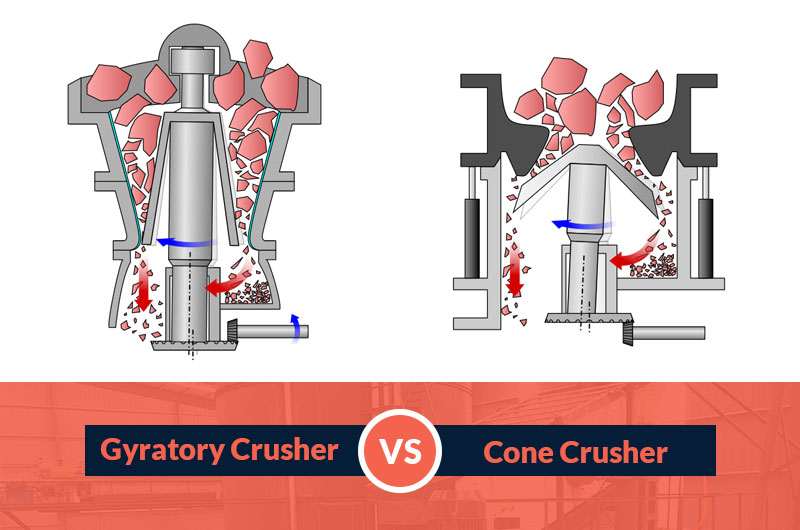
- a. Gyratory crushers are primary crushers that break the largest rocks into smaller pieces. Cone crushers are medium to fine crushing equipment that break smaller rocks into gravel or sand.
- b. Gyratory crushers are stronger than cone crushers and can crush harder materials.
- c. The gyratory crusher provides higher throughput. It is suitable for large-scale crushing production. However, the cone crusher has a finer output size and is more suitable for small operations.
- d. Gyratory breakers require more maintenance and have higher operating costs. Cone crushers are more affordable.
3. Can I use a gyratory crusher for crushing sticky clay?
- No, you can’t. Gyratory crushers are not suitable for crushing clay, as the clay will clog the crusher. If you want to crush clay, jaw crushers and hammer crushers are the ideal primary crushers.
Parameter
| Model | Feeding opening size(mm) | Max.Feeding size(mm) | Adjustment range of discharge port(mm) | Capacity(t/h) | Power(kw) | Dimensions L×W×H(mm) |
| HCG4265 | 1065 | 900 | 152-177 | 2354-4133 | 450 | 3940×4170×6900 |
| HCG5065 | 1270 | 1050 | 152-177 | 2414-4226 | 450 | 4460×4430×7610 |
| HCG5475 | 1370 | 1150 | 152-203 | 2908-5018 | 600 | 4930×4925×8410 |
| HCG6275 | 1575 | 1350 | 152-203 | 2913-6235 | 600 | 5580×5250×9090 |
| HCG6089 | 1525 | 1300 | 177-229 | 4576-8359 | 750 | 5590×5445×10470 |
| HCG60110 | 1525 | 1300 | 177-305 | 5579-14082 | 1500 | 6200×5940×11390 |
Note: Processing Capacity May Vary with Different Materials and Feeding Sizes.
| Model | Feeding opening size(mm) | Max.Feeding size(mm) | Capacity(t/h) |
| HCG4265 | 1065 | 900 | 2354-4133 |
| HCG5065 | 1270 | 1050 | 2414-4226 |
| HCG5475 | 1370 | 1150 | 2908-5018 |
| HCG6275 | 1575 | 1350 | 2913-6235 |
| HCG6089 | 1525 | 1300 | 4576-8359 |
| HCG60110 | 1525 | 1300 | 5579-14082 |
Note: Processing Capacity May Vary with Different Materials and Feeding Sizes.


